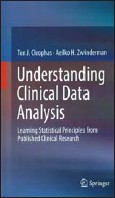Translate this page into:
Understanding Clinical Data Analysis
Corresponding Author:
| How to cite this article: Chawla D. Understanding Clinical Data Analysis. Natl Med J India 2017;30:175 |
Understanding Clinical Data Analysis. Ton J. Cleophas, Aeilko H. Zwinderman (eds). Springer, Germany, 2016. 234 pp, price not mentioned. ISBN 978-3-319-39585-2.

The main obj ective of this book is to review the state-of-the-art of clinical trial analysis including special topics such as stepped wedge design, adaptive design, principal feature analyses and random effect logistic model. In the preface, the authors explain statistical issues using examples from the published medical literature and focus on why-so of analysis rather than how-so.
The book has 10 chapters and starts with an interesting viewpoint on the concept of randomness. From randomness in everyday life to evolution of the scientific rationale behind statistical analysis, the authors explain ‘why-so’ of the concept in a rather philosophical manner. A comprehensive list is given of how the term ‘random’ is used in clinical trials and in statistical analyses. Chapters 2, 3 and 4 deal with randomized trials presenting information about components of a trial protocol, variations of experimental study designs, intention-to-treat or per-protocol analyses, hypothesis statement and stratification. Chapters 5 and 6 present discrete and quantitative analyses including z-test, chi-square test and t-test. However, information about risk ratios, risk difference and odds ratio or about some non-parametric tests are missing. Chapter 7, although titled subgroup analysis, is about regression analysis; 16 pages of this chapter are inadequate to do justice to even basics of regression analysis. A better written Chapter 8 provides information on interim analysis of clinical trials. The alpha spending function is explained with good examples. Chapter 9 deals with multiplicity analysis. The last chapter again turns philosophical to discuss the relationship between disciplines of biology and mathematics.
There are many glaring shortcomings in the book. Starting from Chapter 1, extensive use of terms such as probability, normal distribution and null hypothesis without first introducing and explaining them would make it difficult for a novice to understand how randomness relates to the theory behind statistical tests. In fact, this name-dropping or listing concepts without any explanation recurs throughout the book. While trying to explain difference between odds ratio and relative risk in Chapter 2, the authors just give a formula for calculation. For a reader who wants to understand the concept behind calculations, the authors say: ‘In case of case–control studies RR is nonsense.’ Some information is incorrect, e.g. ‘continuous variables are used for description of efficacy and binary data is used for describing side-effects’, ‘Trials, involving repeated measurements in one subject, are often called crossover trials’. Methods of generating random number sequence (bucket with notes or random number generator) are confused with types of randomization (simple v. block) and are presented as a single list (again without any elaboration). Line figures or graphs do not only convey information efficiently, but also help in understanding difficult concepts. However, this book has not been able to use the power of illustrations. Figures are neither numbered nor referred to in the text. Most of the figures have no legend. For example, the directed acyclic graph in Chapter 3 or the survival curve in Chapter 5 are wasted without accompanying explanation. Each chapter contains a number of graphs from published articles. Many of these graphs ‘SO-HIP study’ (p. 55) have no accompanying reference to the articles from where these have been reproduced and some are even impossible to read because of poor resolution (p. 52). The book is in English but some of the figures are in Danish (pp. 5, 134). Some chapters have irrelevant self-promotion (p. 97). Each chapter ends with an identical list of books written by the authors themselves. No reference to published articles, books or monographs is provided at the end of any chapter or the book.
I do not think the book meets its stated objectives. It is hard to recommend this book to anyone. Students wishing to learn statistical analysis will not gain any knowledge of concepts from this book while experts looking for special statistical methods will find incomplete handling of the topics frustrating.
Fulltext Views
980
PDF downloads
935




